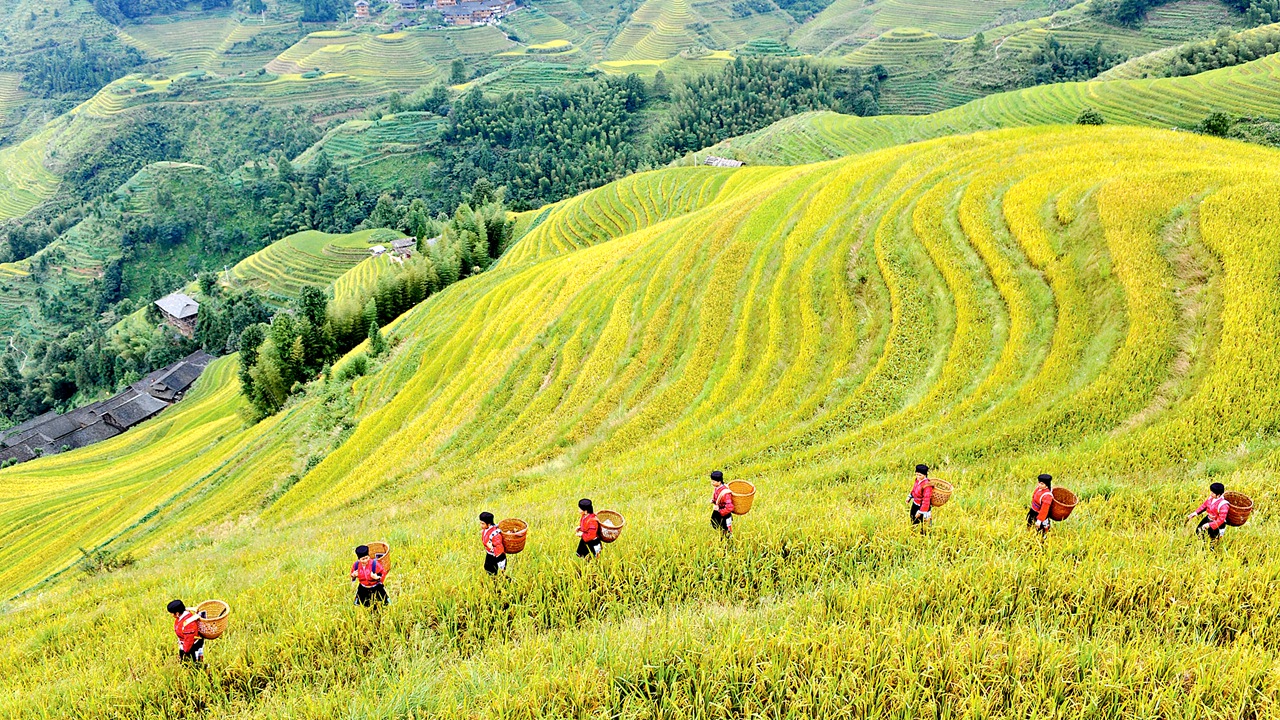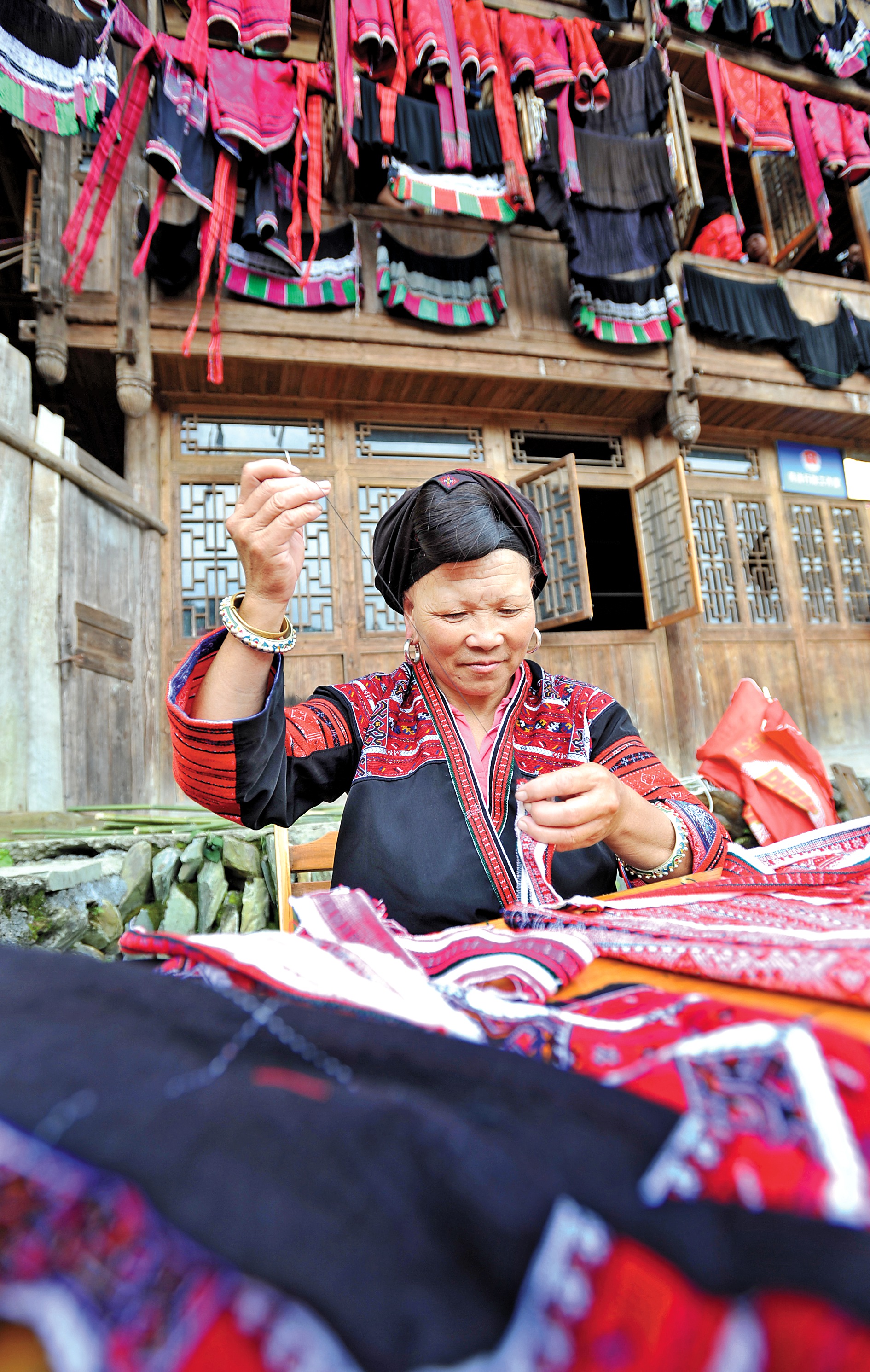Villages vitalized by terraces to heaven
Writer: | Editor: Zhang Zeling | From: | Updated: 2024-04-16
Nestled approximately 700 kilometers northwest of Shenzhen, the Longsheng Autonomous County in Guangxi features a tapestry of terraced landscapes alongside villages steeped in rich histories and vibrant minority-group cultures.
The period of May and June ushers in the enchanting spectacle of the terraces glistening with water, while come October, the picturesque transformation of the rice paddies to a golden hue captivates visitors, drawing in a multitude of photography enthusiasts annually.
A journey to this captivating village takes an eight-hour drive from Shenzhen, leading you to an extraordinary destination recognized among the Best Tourism Villages by the World Tourism Organization in 2022. Alternatively, you can take a high-speed train departing from Shenzhen to Guilinbei, a route taking approximately three hours. From there, a mere one-hour taxi ride will transport you to this enchanting spot of natural beauty and cultural significance.

Villagers walk through a terraced rice field in autumn at Dazhai Village in Longsheng, Guangxi. Photos by Xinhua
Various-sized oxen made of bamboo strips with colorful cloth for the head and tail danced to the accompaniment of gongs and drums. Farmers dressed in distinctive Dong outfits holding plows and whips followed closely in their wake.
The performance took place as part of recent spring celebrations in Guangnan Village, Longsheng Autonomous County of various ethnic groups in Guilin in the Guangxi Zhuang Autonomous Region, which is home to many ethnic minorities.
For centuries, the dancing spring oxen have not only been viewed as divine by the villagers, but have also embodied their hopes for better lives in the new year.
Mountains, scarce farmland, and poor transportation once sealed Guangnan off from the outside world and with just a few acres of paddy fields, local residents used to struggle to make ends meet, which is why the ox is the villagers’ best helper, says Wang Kaiqi.
“We have a profound respect and love for cattle,” the villager in his 70s says.
Today, oxen are no longer important agricultural tools, and the narrow rural paths they used to plow have turned into wide roads, along which agricultural machinery and all sorts of small cars shuttle back and forth.
Since 2021, Guangnan has been Longsheng’s model for rural vitalization and more than 10 million yuan (US$1.38 million) has been invested to upgrade roads, river embankments and traditional homes. As a result, the village has attracted visitors from institutes of higher learning across the country on learning tours.
Guangnan is just the tip of the widespread transformation that has taken place across Longsheng, which was recently ranked among the upcoming top 10 rural vitalization models by the Ministry of Culture and Tourism.
In 2023, Longsheng county received 10.11 million visits, an increase of 67.27% compared to the previous year, and tourism spending reached 12.6 billion yuan, an increase of 66.35% year-on-year, according to county authorities.
About 90 kilometers away to the southeast, residents of Dazhai village earned collective tourism dividends of 7.25 million yuan last year.

A villager demonstrates the traditional cloth-making skills of the Yao ethnic group at Dazhai Village, Longsheng, Guangxi.
This was a big contrast from the 25,000 yuan they earned in 2003, the 147,000 yuan in 2008, and the 1 million in 2013, says Yu Qiongtong, a senior village committee official in Dazhai.
Surrounded by mountains on all sides, there was once only a muddy path leading out of the village. People carried goods on their backs or on mules and lived in stilt houses that were drafty and leaked when it rained. Now, local authorities have managed to turn those basic conditions into attractions.
For example, Dazhai boasts around 66 square kilometers of terraced fields that have been cultivated for around 2,300 years. They follow the terrain of the mountains, at heights ranging from 300 to 1,200 meters above sea level. From swiftly flowing river valleys to mist-covered mountains, dense forests and steep cliffs, wherever there is water and soil, terraces have been dug.
Those in Dazhai are important representatives of Longji terracing, a well-known type of terrace that can be found all over the county.
“The highest tier has more than 1,100 levels, winding from the foot of the mountain to the top, creating a magnificent landscape that resembles a staircase to the clouds,” Yu says.
Longji terraces are based on an environmental practice that focuses on harmony between humans and nature and the dynamic balance of forests and fields.
It is an important model of ancient Chinese water management and agricultural civilization that has been passed down to the present day.
Visitors can appreciate the way the Zhuang and Yao ethnic groups have farmed the terraces and how ancestral farming methods have been preserved.
Every year after the Qingming Festival, villagers begin a series of agricultural activities such as planting and harvesting that have given rise to celebrations. These festivities have become a rich resource for developing tourism, according to Yu.
In 2022, the village was named among the Best Tourism Villages by the World Tourism Organization, thanks to its achievements in balancing tourism and economic development, while protecting the environment.
More than 200 households in the village run homestays, around 70% of which are booked during peak tourist periods, mostly in summer and autumn.
“Next, we aim to introduce more cultural and tourism-related projects suitable to the area, to enrich the experience and further the development of the cultural and tourism sectors,” Yu says. “At the same time, we will continue to strengthen the protection of our culture, terraced landscapes, and traditional architecture, to ensure that terrace culture continues to thrive in our generation.”
Multiple folk festivals based around ethnic costumes and artifacts, farming culture, revolutionary history and health preservation have been launched.
“Next, Longsheng aims to create a world-class tourism destination and demonstration area for ethnic cultural tourism in Guilin,” says Lei Chen, Longsheng Party secretary. (China Daily)